 |
SRGC Bulb Log Diary |
| Home Recommend This Site To A Friend |
|
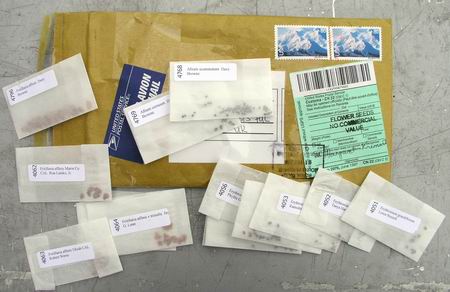
NARGS seed It is that time of year when we look for our seed allocation arriving in the post from the various seed distributions run by the SRGC, NARGS, AGS etc. I would like to thank all the volunteers of all the seed exchanges who put in a mountain of work to ensure that we get our packet of seed delivered to our doors. Once we receive the seed it is our responsibility to ensure that we give it the very best chance of germinating, growing and in turn producing seed that can be donated to future seed exchanges. My selection from the NARGS exchange is mostly wild collected Erythronium and Fritillaria species (no surprise there) with a few Allium, Cyclamen and Trillium to make up the numbers. As I believe that it is too late to sow the frit seed, it has gone straight into the fridge and will be sown in September, the rest has been sown.  Soaking erythronium seed I always soak stored erythronium seed for 24 hours or so before I sow it. Plastic milk bottle tops have a million uses including being perfect receptacles for soaking seed. I add a tiny amount of soap to the water, just enough to break the surface tension and allow the seeds to sink. You will be amazed at how much the seeds can swell after a good soak, they look like they did when they were removed from the seed capsule and it gives them a higher chance of germinating in the first year. The close up picture on the right shows the plump seeds after soaking, there are a few sterile seeds floating on the surface - they were all shriveled and wrinkled 24 hours earlier. 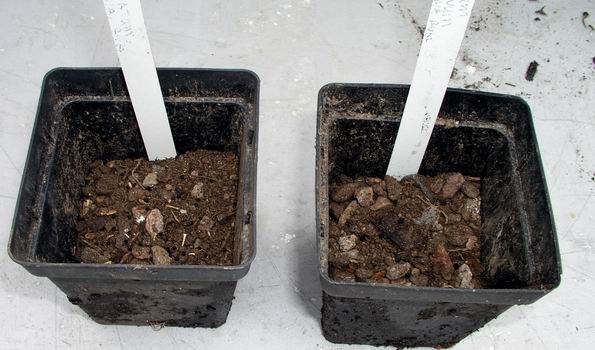 Sowing seed deep Just to remind you that I like to sow a lot of seed deeply in the pot. I show you two pots of allium seed, filled to less than half way with compost, then I sow the seed (you can just make out the shiny black seeds) then I add more compost before a final layer of gravel. 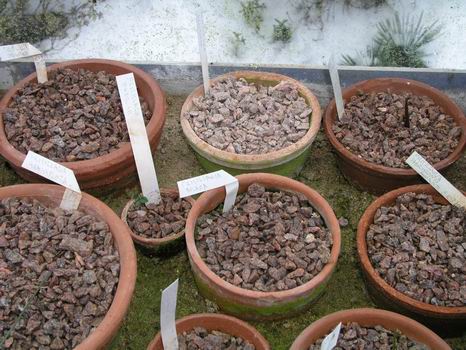 Dry pot The weather is cold and damp so I thought it a good time to check the frit house to see how things are doing. It is in these conditions that any pot that is a little too dry will show up like the centre pot in the top row. You can see quite clearly that all the other clay pots have dark moist sides and the gravel layers are also darker because of the moisture - any that are pale and dry need your attention and a good watering as soon as long as the temperatures are above freezing.  Slate in hole. It is also just now, and before I water the frits, that I remove a pot that I might want to take to a show and place a bit of slate in the bottom of the hole. This is to discourage the roots from coming out the drainage hole and growing into the plunge, which they would do shortly if I do not take this measure. 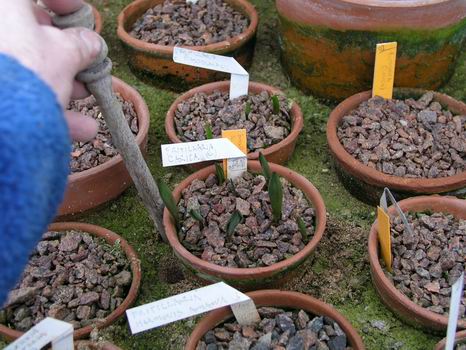 Firming in Once you replace the pot is important to firm it in by tamping the sand down all around to ensure that there is a good contact to allow free passage of moisture between the sand and the pot. I have also given all the frits a good soaking today as they were getting quite dry and there are a lot of shoots starting to show through the gravel. 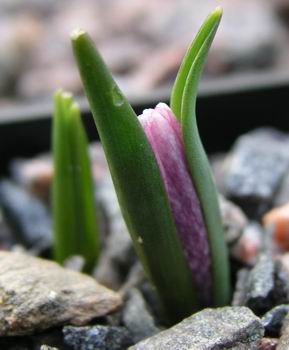 Frit alburyana. No need for watering in the outside frame where this Frit alburyana is growing in a plastic pot. The only time this frame has been covered this winter was last week, when we had 15cms of snow. Since the snow has gone, the temperature has shot up to a high of 12C yesterday causing a positive explosion of bulbs to appear.  Crocus & Iris. The first Iris 'Katherine Hodgkin' has opened (above right) and Crocus sieberi atticus (left) is also opening in the same bed. Under glass it is a crocus bonanza here are a few of them. 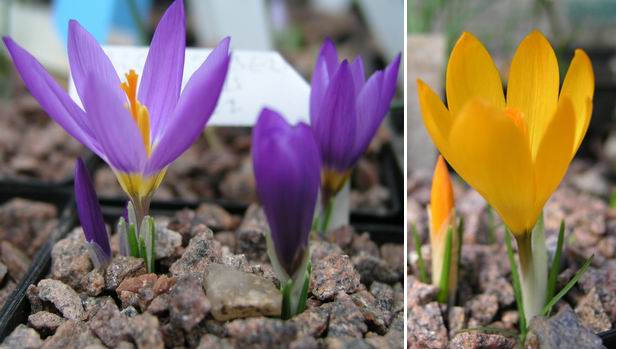 Crocus sieberi nivalis & cvijicii. I showed you a picture of Crocus sieberi nivalis before it opened fully last week and here it is now. That is one of the good things about crocuses they have two distinct decorative stages; the first when the flower is shut and a second more spectacular display when they open - so you will more than likely see the next few crocuses again in the coming weeks.  Crocus reticulatus & fleischeri  Crocus sieberi & biflorus. I find Crocus sieberi ssp sieberi, on the left, a bit tricky, some years it does very well and the next it sulks - I do not think that it likes to be too cold nor too wet and it certainly does not like a cold wet combination. On the right hand side is Crocus biflorus ssp alexanderii. Thanks to the bulb log feed back on the forum and Diane, I can now pollinate the iris and thanks also to Tony for sharing some of his extensive collection of crocus with us. Please get involved in the forum - don't just look; join in and make a post. ^ back to the top ^ |